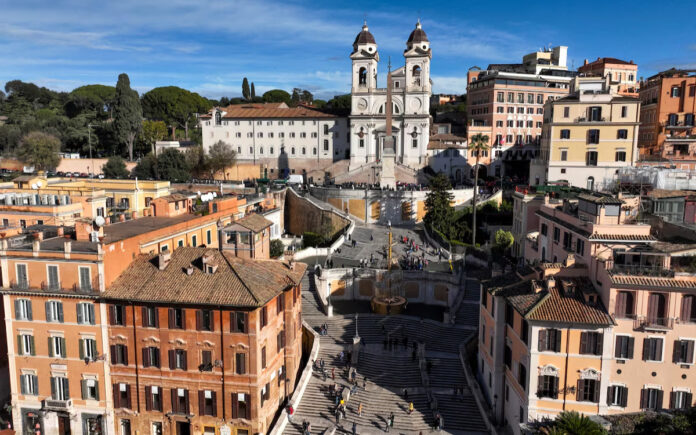Rome: After years of dominance by Milan, professional real estate investors are turning their attention to Rome as the Italian capital undergoes a transformation. Italian architect Giuseppe Pezzano, who previously invested in Milan, is now seeking a second home and studio in Rome, drawn by its historic charm and emerging opportunities.
Pezzano’s move reflects a broader shift in the property market. Over the past five years, Milan attracted more than half of all professional real estate investments in Italy, according to data from think tank Scenari Immobiliari. However, soaring property prices and investigations into fast-tracked building permits have slowed Milan’s momentum. Meanwhile, Rome is gaining traction, thanks to increased public spending for the upcoming Holy Year and a more investor-friendly approach from local authorities.
Rome’s Property Market Gains Momentum
“In Milan, €400,000 ($420,000) gets you a small, unattractive one-bedroom apartment, while in Rome, you can live in a late 19th-century building,” Pezzano noted. “Rome’s architecture, its open views, and its people make it the most beautiful city in the world. I want a window that looks out onto that beauty. And I think I can find new clients there—Rome is on the cusp of an architectural renaissance.”
Rome accounted for 17% of all professional real estate investments in Italy last year, up from an average of 11% between 2020 and 2024, according to property services firm JLL. Investments in the city doubled year-over-year to €1.7 billion in 2024.
The Holy Year, expected to attract an additional 10 million visitors to last year’s record 22 million tourists, has fueled up to €8 billion in public spending on urban renewal and infrastructure upgrades. In December, Rome’s city council approved new town planning regulations—the first update since 2008—to further encourage redevelopment in a city rich with ancient ruins and world-famous landmarks.
Rome’s Real Estate Renaissance
As Rome works to bridge the efficiency gap with Milan and address issues like unreliable public transport, poor road conditions, and waste management, major investors are taking notice.
Global real estate investment firm Hines is negotiating its first project in Rome after previously focusing on northern Italy.
“We believe Rome has the potential to experience the real estate renaissance that Milan has undergone over the past decade,” said Mario Abbadessa, head of Hines Italy.
Rome’s property prices remain significantly lower than those in Milan. In central Milan, apartments cost between €12,000 and €14,000 per square meter, compared to €8,000 to €9,000 in Rome—a gap Abbadessa described as “excessive.” Rome is also more affordable than other southern European capitals like Lisbon or Athens.
Milan’s real estate boom was triggered by the 2015 World Expo, with house prices rising 27% on average between 2014 and 2024, and up to 52% in semi-central areas, according to consultancy PwC. In contrast, Rome’s house prices have fallen by 14.4% over the past decade, according to think tank Nomisma.
Investors see potential. Czech firm CPI Property Group has focused its €1.5 billion Italian real estate portfolio primarily on Rome, up from just €53 million in 2018. Italian developer Hera Holding has also expanded its Rome investments, which now account for more than half of its €30 million property portfolio, up from one-fifth in 2018.
Tackling Bureaucracy and Investor Concerns
Rome’s city administration acknowledges past challenges in attracting investment. Many local construction firms, often small family-owned businesses, did not survive Italy’s economic downturns between 2008 and 2013.
“Outsiders were not interested in stepping in because of the ‘bureaucracy risk,’” said Rome city councilor Maurizio Veloccia. “Projects stalled halfway, and this reinforced the perception that real estate investments were too risky.”
In a bid to change that perception, Rome has reopened its urban planning department to the public, reversing a pandemic-era digital-only policy. It has also streamlined approval processes, increased decision-making powers for city officials, and lifted restrictions such as a cap of 60 rooms for hotels in the city center. Additionally, 700 buildings were removed from a list of protected properties, easing renovation regulations.
“With the Jubilee acting as a catalyst, Rome must now prove it can address the issues that have long held back real estate investments,” said Francesca Zirnstein, director general of Scenari Immobiliari.
Reviving Long-Stalled Projects
Some long-abandoned construction projects are finally moving forward. One notable example is the “Ex Fiera di Roma” site, a 76,000-square-meter former convention center that has remained dormant for two decades. A fund backed by UniCredit and Illimity now owns the site, and developer ARECneprix is converting more than half of it into residential buildings, including social housing.
Social housing is a key focus for Rome as it seeks to avoid Milan’s challenges, where rising property values have priced out residents while wealthy foreign investors take advantage of tax incentives.
Unlike Milan, Rome’s sheer size and demographics—characterized by a mix of families, students, and long-term residents—make it less susceptible to rapid gentrification.
Also Read | EU Must Act Now: Tusk Demands Confiscation of Russian Assets for Ukraine
“I don’t see Rome becoming another Milan,” said local resident Paola Salvetti. “It’s too big and full of families and students, not just high-flying professionals.”
With renewed investment interest, government support, and a commitment to modernization, Rome appears poised for a real estate revival—one that could redefine its position in Italy’s property market.



